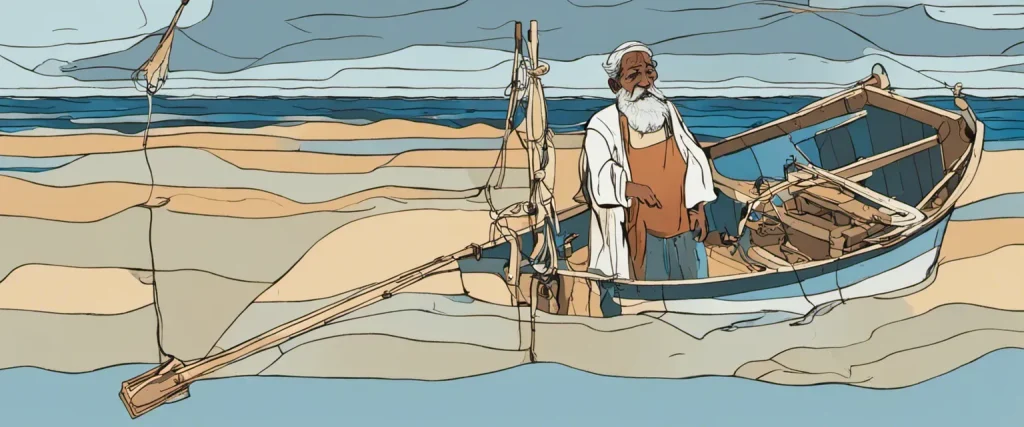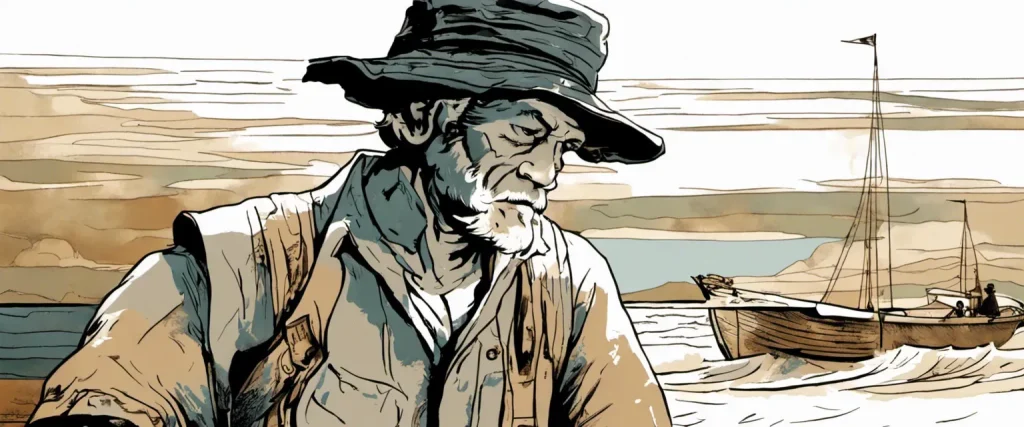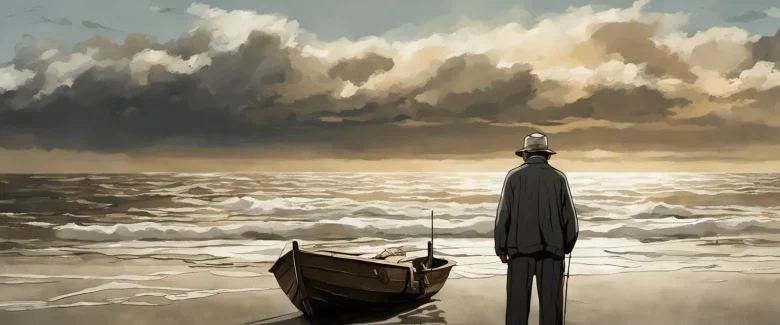In the novella, The Old Man and the Sea, written by Ernest Miller Hemingway, we are immersed in the solitary world of Santiago, an aged fisherman determined to break his run of bad luck. Hemingway, a highly influential American novelist and journalist, known for his concise and understated writing style, explores themes of perseverance, nature, and the indomitable spirit of the human experience. Published in 1952, this poignant tale takes us on a journey of struggle and triumph, as Santiago battles against nature and his own physical limitations in pursuit of the elusive marlin.
Chapter 1: Introduction and Setting
Chapter 1 of “The Old Man and the Sea” by Ernest Hemingway introduces the reader to Santiago, an aging Cuban fisherman who has been unlucky in catching fish for the past 84 days. Despite this unfortunate streak, Santiago remains hopeful and determined to prove his worth as a fisherman.
The chapter begins by describing Santiago’s modest home, a small shack with a dirt floor and walls featuring faded pictures of bullfighters. Hemingway skillfully establishes the setting of a small fishing village near Havana, where Santiago sets out each day on his skiff to fish in the Gulf Stream.
Through conversations with Manolin, a young boy who greatly admires Santiago and has learned fishing from him, we learn about Santiago’s reputation as a skilled fisherman. However, his recent run of bad luck has caused other fishermen to doubt his abilities, and they encourage Manolin to fish with more reliable boats. Despite this, Manolin stays loyal to Santiago and helps him carry his fishing gear.
As Santiago embarks on yet another fishing trip, Hemingway vividly describes the sea as an unpredictable and violent force, foreshadowing the challenges that lay ahead for Santiago. Once deep into the sea, Santiago deploys his lines and begins his patient wait for a catch.
The chapter ends with a glimpse into Santiago’s loneliness and his spiritual connection with the sea, as he speaks to himself and refers to the sea as a woman who is both loving and treacherous. This further emphasizes Santiago’s deep respect and love for the ocean, making it clear that his identity is intertwined with his profession as a fisherman.
Overall, Chapter 1 sets the stage for Santiago’s struggle against nature and his determination to prove himself as a resilient and skilled fisherman, despite his recent failures.
Chapter 2: The Marlin’s Capture
Chapter 2 of “The Old Man and the Sea” by Ernest Hemingway, titled “The Marlin’s Capture,” continues the story of Santiago, an old and determined fisherman, as he embarks on his difficult journey into the Gulf Stream. Determined to prove himself once again after a long streak of bad luck, Santiago sets out farther than any other fisherman into the sea.
Santiago’s journey reveals his deep connection with nature as Hemingway describes the various marine creatures encountered along the way. Santiago forms a special bond with the flying fish, feeling a kinship with their struggle for survival. This connection highlights Santiago’s respect for other living beings, emphasizing his code of honor and empathy.
After days of perseverance, Santiago finally feels a tug on his line, signaling his long-awaited encounter with a mighty marlin. The struggle between man and fish begins, with Santiago desperately holding onto his line and praying for strength. The marlin, an enormous fish, pulls Santiago’s skiff through the water, challenging the old man’s physical and mental endurance.
As the battle wages on, Santiago’s hands and back ache, but his determination remains unyielding. He talks to himself, offering encouragement and motivation. He reminisces about his younger days and expresses admiration for the marlin’s strength and beauty, further illustrating his deep appreciation for the natural world.
As the chapter concludes, Santiago finds himself locked in a stalemate with the marlin, the fish unable to make any further progress against the relentless fisherman. Santiago is exhausted but hopeful, knowing that his struggle is far from over. The battle draws to a close, leaving readers eager to discover the outcome of this epic struggle and to witness the old man’s triumph or defeat.
Chapter 3: The Battle Continues
Chapter 3: The Battle Continues of “The Old Man and the Sea” by Ernest Miller Hemingway follows the protagonist, Santiago, as he continues his struggle to catch the marlin.
The chapter begins with Santiago waking up from an unsettling dream about his youth, highlighting his inner turmoil and doubts. Despite this, Santiago remains determined to prove himself as a skilled fisherman. He thinks of DiMaggio, a baseball player who endured pain to achieve greatness, inspiring him to endure his own physical pain and exhaustion.
As the day progresses, Santiago engages in an intense battle with the marlin. The fish pulls the boat further out to sea, causing Santiago to marvel at its strength and willpower. Santiago endures the discomfort of cramped hands and aching leg muscles, feeling a sense of kinship with the marlin as they both strive to survive and conquer one another.
Throughout the chapter, Santiago reflects on his loneliness and the absence of a loyal fishing partner, a boy named Manolin. He misses the boy’s youthful energy and companionship. However, he holds onto the idea that Manolin will return to him someday, knowing that their deep bond will live on.
As the sun sets, Santiago enters yet another phase of the battle with the marlin. He must carefully fight and navigate the fish, wary of the possibility of losing it. Santiago shows resilience and perseverance, willing himself to give his all in capturing the marlin, despite the immense challenges he faces.
Chapter 3 – The Battle Continues – leaves the readers with a sense of anticipation, as they are left wondering whether Santiago will successfully triumph over his formidable opponent.
Chapter 4: Sharks Attack

In Chapter 4 of “The Old Man and the Sea” by Ernest Hemingway, Santiago is engaged in a tense battle against a marlin that he hooked on his fishing expedition. As the old man struggles to reel in the enormous fish, he feels a sense of admiration and respect for his opponent. He considers the marlin a worthy adversary, one that deserves to be respected even in death.
During this intense struggle, Santiago’s fishing line is suddenly attacked by a pack of hungry sharks. The sharks attack with ferocity, tearing into the marlin’s flesh, leaving Santiago devastated. He fights valiantly, trying to ward them off by stabbing at their heads with a makeshift harpoon, but there are too many of them, and they slowly strip the marlin of its flesh, leaving only its skeleton behind.
Santiago’s heart sinks as he watches the sharks decimate his long-awaited prize. He feels a sense of deep loss and grief for the magnificent creature that battled him for so long. Despite his despair, he remains determined and vows to continue his fight against the destructive forces of nature.
Despite the loss of the marlin, Santiago’s indomitable spirit remains unbroken. He reflects on the hardships he has endured throughout his life as a fisherman and recognizes that he must continue to battle on, even in the face of constant disappointment and hardship. Santiago’s unwavering perseverance is a testament to the human spirit and the enduring power of the individual against the unpredictable forces of nature.
Chapter 5: A Sense of Defeat
Chapter 5, “A Sense of Defeat,” in Ernest Hemingway’s novel The Old Man and the Sea, focuses on the internal turmoil and emotional battle Santiago faces after battling with the marlin for three days.
The chapter begins with Santiago feeling great physical pain and exhaustion, as the cuts on his hands have become infected. Still, his determination remains unbroken. Despite his persistent optimism, Santiago starts to doubt himself, feeling a sense of defeat. He begins to question his own skill and whether his efforts were worth it.
As he sails back to the shore, Santiago is haunted by the sharks that have devoured the marlin’s flesh, leaving only its skeleton. The skeletal remains, strapped to the side of the boat, act as a stark reminder of his devastating loss. Santiago feels like a failure, as others perceive him as unlucky and incapable of catching fish. This sense of defeat is overwhelming and crushes his spirit.
Throughout the chapter, Santiago reflects on his past, remembering his triumphant moments as a young and strong fisherman. Now, age and physical frailty have caught up with him, and he laments his weakened state. Despite his feelings of defeat, Santiago remains resilient, determined to continue his love for fishing and proving himself on the sea.
In this chapter, Hemingway highlights Santiago’s internal struggle, the weight of defeat, and the toll it takes on his psyche. It emphasizes themes of resilience and the never-ending battle one faces in the pursuit of their dreams. As the chapter concludes, Santiago is left with a bittersweet taste, knowing that despite his physical loss, he will cherish the memory of his epic battle with the marlin forever.
Chapter 6: Returning Home
Chapter 6: Returning Home of “The Old Man and the Sea” by Ernest Hemingway continues the story of Santiago, the old fisherman, as he returns to his hometown after his arduous battle with a giant marlin. Exhausted and with his body showing signs of the relentless struggle, Santiago’s return evokes mixed responses from the villagers.
As Santiago arrives, the carcass of the magnificent marlin, now reduced to bones, is tied to the side of his boat. The sight of the skeleton attracts the attention of the fishermen, who are astonished by the size of the fish. Santiago’s loyal young apprentice, Manolin, rushes to help him carry his equipment back to his home. Santiago’s physical state serves as a testament to the immense fight he encountered during his journey, showcasing his indomitable spirit and willpower.
Upon reaching his shack, Santiago collapses onto his bed, completely exhausted. He dreams of the lions he once saw on the beaches of Africa, a representation of his youthful vigor and resilience. Meanwhile, Manolin—the boy who has followed Santiago’s fishing endeavors since childhood—expresses his admiration and respect for the old man’s courage.
News of Santiago’s triumph spreads throughout the village, and the local fishermen gather around his shack to marvel at the remains of the giant marlin. Some skeptics, however, attribute Santiago’s success to mere luck. The old man’s detractors include two fishermen named Pedrico and Martin, who mockingly comment on his misfortune of going 84 days without catching a fish before finally landing the colossal marlin.
Despite the skepticism and mockery, Manolin remains fiercely loyal and continues to believe in Santiago’s greatness. He pledges to defy his parents’ wishes and once again sail with the old man, proving his unwavering loyalty and devotion.
The chapter ends with Santiago enjoying some much-needed rest, dreaming of the magnificent marlin and the beauty of his past encounters with the sea. His triumphant return, even in the face of skepticism, marks a significant moment in the novel, symbolizing the indomitable human spirit and the resilience of a man who refuses to be defeated.
Chapter 7: Man vs. Nature
Chapter 7: Man vs. Nature in the book “The Old Man and the Sea” by Ernest Miller Hemingway is a pivotal point in the story, where the relentless battle between Santiago, the old fisherman, and the forces of nature intensifies.
The chapter starts with Santiago realizing that he has hooked the biggest fish he has ever encountered, a magnificent marlin. However, the fish is strong and refuses to be caught easily. Santiago’s hands are cut and bleeding from holding onto the fishing line. He is exhausted, but his determination and pride push him to continue fighting.
Nature is presented as a powerful and unforgiving force in this chapter. Santiago and the marlin engage in an epic struggle that showcases the brutal strength of the sea. The old man realizes the violence of nature, feeling insignificant against the vastness of the ocean. However, he never loses hope and relies on his years of experience to outsmart the fish. He uses different tactics and strategies to tire the marlin, despite being wounded and fatigued himself.
Throughout the chapter, Santiago’s will and perseverance are tested. He remains resolute and determined, displaying immense courage and a refusal to yield to the challenges thrown his way. The intense physical and mental battle becomes a reflection of the broader theme of the human struggle against larger forces in life.
Eventually, after an arduous and exhausting struggle lasting two days and nights, Santiago manages to harpoon the marlin. As he begins the lengthy journey back to the shore, however, his boat is attacked by sharks attracted by the scent of blood from the marlin. Santiago valiantly fights them off, but they devour most of the fish, leaving only its skeleton. Santiago’s triumph is bittersweet, as his prize is taken away from him. Yet, his inner strength and resilience remain unshaken.
Chapter 7 serves as a turning point in the novel, demonstrating Santiago’s unwavering determination, the grandeur and power of nature, and the fleeting nature of victory.

Chapter 8: The Aftermath and Redemption
Chapter 8, titled “The Aftermath and Redemption” in Ernest Hemingway’s novel The Old Man and the Sea, is the final chapter of the book. Following the intense struggle between the old fisherman Santiago and the marlin, the story delves into the aftermath of his journey and his redemption.
In the beginning, Santiago is shown navigating his way back to the shore, his small skiff being tugged by the great marlin’s carcass. The old man is exhausted, as he had to fight the fish for three days without rest. Along the way, he faces numerous trials, including sharks attacking and devouring most of the marlin’s flesh. Santiago valiantly manages to fend off the sharks, but arrives back at the shore only with the marlin’s skeleton.
As the old man drags himself home, the townspeople are amazed by the sight of the huge fish’s skeleton, even though most of its meat has been eaten away. Manolin, Santiago’s young apprentice, is heartbroken at the state of his mentor but remains devoted, pledging to never abandon him again. Santiago sinks into a deep sleep, dreaming of lions, symbolizing his lost youth and strength.
When the old man awakes, he is greeted by the presence of Manolin and a renewed sense of hope. They make plans to fish together again, despite the belief that Santiago is cursed, as they both understand the eternal cycle of life and the important lessons learned from Santiago’s experience.
In this chapter, Hemingway portrays Santiago’s struggle and ultimate triumph as a testament to the indomitable human spirit. Despite his physical defeat, Santiago finds redemption as he refuses to be broken by the challenges he faces. This final chapter highlights the themes of perseverance, resilience, and the meaningfulness of the journey itself, even in the face of failure. The story concludes on a poignant and optimistic note, emphasizing the importance of companionship and the value of never giving up.
After Reading
In conclusion, “The Old Man and the Sea” by Ernest Hemingway is a poignant and powerful tale of courage, perseverance, and the indomitable spirit of the human soul. With its vivid descriptions of nature and the raw emotions woven throughout, the novel explores themes of man’s relationship with nature, the struggle against adversity, and the enduring quest for meaning and purpose. Through the remarkable character of Santiago, Hemingway reminds us of the strength we possess within ourselves to face life’s challenges head-on, even in the face of seemingly insurmountable odds. This timeless classic serves as a testament to the resilience of the human spirit and the timeless allure of the sea.
Book Recommendation:
If you enjoyed reading “The Old Man and the Sea” by Ernest Miller Hemingway, here are five book recommendations that offer diverse genres and captivating narratives:
1. Hopscotch” by Julio Cortázar:
This avant-garde masterpiece is a must-read for enthusiasts of experimental literature. “Hopscotch” is an intriguing narrative that plays with structure and storytelling techniques, allowing readers to choose their own path through the book. It explores themes of love, loss, and existentialism, providing a unique and exhilarating reading experience.
2. “Fahrenheit 451” by Ray Bradbury:
For fans of dystopian fiction, “Fahrenheit 451” is an absolute must-read. This thought-provoking novel depicts a future society where books are banned, and intellectualism is heavily suppressed. The story follows the journey of a “fireman” named Guy Montag, who begins to question the system as he encounters those who dare to preserve literature.
3. “Little Women” by Louisa May Alcott:
After immersing yourself in Hemingway’s poignant tale, “Little Women” offers a beautiful and heartwarming contrast. Set in the 19th century, this classic novel explores the lives of the four March sisters—Meg, Jo, Beth, and Amy. Through their joys, struggles, and personal growth, Alcott presents a timeless portrayal of family bonds, societal expectations, and the pursuit of dreams.
4. “The Name of the Wind” by Patrick Rothfuss:
If you crave an immersive fantasy experience, consider diving into “The Name of the Wind.” This epic tale follows the life of Kvothe, a renowned magician, musician, and storyteller whose past is shrouded in mystery. Rothfuss weaves together a richly detailed world full of magic, adventure, and intricate character relationships, leaving readers eagerly awaiting the next installment.
5. “The Stranger” by Albert Camus:
For those who appreciate Hemingway’s sparse writing style and existential themes, “The Stranger” is a compelling choice. Camus delves into the philosophical nature of human existence through the character of Meursault, a detached and indifferent individual who becomes embroiled in an unsettling series of events. This introspective novella explores themes of alienation, absurdity, and the search for meaning.
These diverse novels provide a range of subjects, styles, and themes to ensure you embark on exciting literary journeys. Whether you’re interested in experimental narratives, dystopian futures, coming-of-age stories, fantasy epics, or existential inquiries, these books are sure to capture your imagination and enrich your reading experience.



